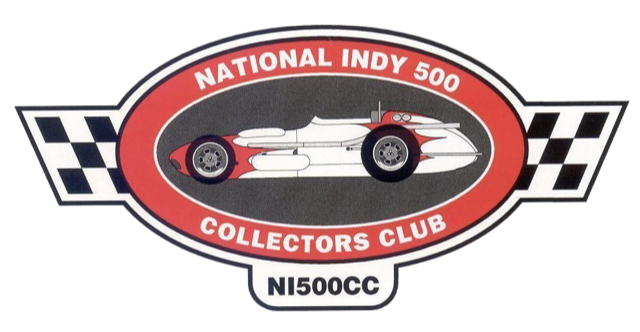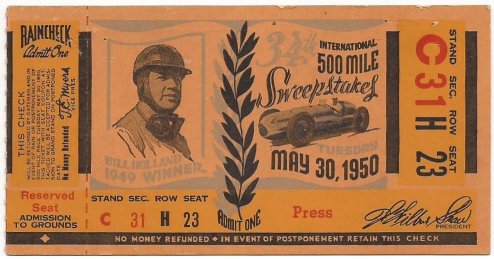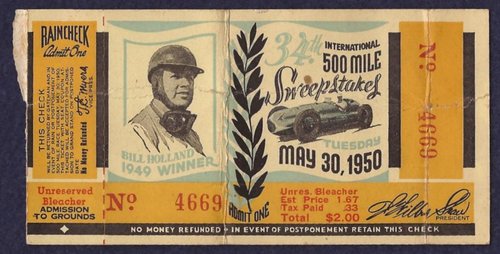The Post War Hulman/Shaw Era – 1946-1955
After 4 years of war, Speedway owner Capt. Eddie Rickenbacker had other ventures he wished to pursue so he expressed a desire to sell the Speedway. Three time winner Wilbur Shaw didn't want to see the Speedway go the way of a housing development, so he looked for interested buyers who would preserve the Speedway. He found such a buyer in Anton "Tony" Hulman Jr. and in late 1945, he and Wilbur negotiated with Capt. Rickenbacker for purchase of the Speedway.
It would take a miracle to get the Speedway ready for a race that was a short 7 months way - the Speedway was in terrible condition and all the logistics in preparing for and running the race had to be completed in that time.
On May 30th 1946, Tony and Wilbur were pleasantly surprised by the record traffic jam trying to enter the Speedway - they had pulled off a miracle as the 30th running of the Indianapolis 500 Mile Race was a success.
The 1946 ticket continues with the car or track design as in previous years. It is the same **dimensions (4 3/4" x just over 2 1/3") as the 1935-41 stubs and like the 1940 unused ticket, there is a perforation between the gateman’s stub and the rain check, but not between the gateman’s stub and the portion to the left. Wilbur Shaw now appears as President at lower right and T.E. Meyers Vice. Pres. remains on the rain check and will remain so through 1954. The ticket maker remains "Weldon, Williams & Lick, Ft. Smith, Ark.".
There appear to be two different general admission tickets for 1946. One that is the previous size as 1941 (1 3/4" x 3 1/4") and one that is more square measuring 2" x a little over 2 1/4". The latter will become the general admission standard for 1947 to *present. The square portion of the general admission ticket below does not have the year on it while the smaller portion does have the year. Note that both the "Press" and the "Complimentary" vertical general admission tickets have the serial number punched in them like the 1937, 1939 and 1941 (see the 1930-1941 tickets page).
1947 marks the first year a picture of a driver appears on a ticket with Wilbur Shaw, three time winner and the current Speedway President at the time, being featured. 1946 winner George Robson may well have been featured on the ticket but as he was killed racing in September of 1946, the Speedway more than likely decided not to use his image possibly out of respect*. This is the first time a picture appears on a ticket* since 1912*. Except for 1981 and 1982, the winner or a driver will appear on the ticket from 1947 through today. The size remains the same as 1946 for the grandstand stubs through 1953 with a size change to 5 1/8" x 2 1/2" in 1954.
Three perforations are now present on unused grandstand seat tickets: between the Admission To Grounds and Gateman’s Stub, the Gateman’s Stub and the rain check and between the rain check and stub. This will remain so through 2015 as perforations were eliminated from all tickets with the plastic ticket of 2016 thus making all tickets from this point forward unused as there were no perforations to tear anything from the ticket.
Up until this point, those with grandstand tickets had to also purchase a general admission ticket in order to enter the grounds. The 1947 grandstand ticket eliminates the need for a general admission ticket as that is part has now been incorporated into the grandstand ticket as seen at left on the ticket above as “Admission To Grounds”. Why it took the Speedway nearly 40 years to do this is a mystery.
Complimentary, Press, Participant, Official, etc. are the same except there is no perforation between the Admission to Grounds and the Gateman's stub but there is a perforation on the right side between the rain check and the stub. There is also no diagram of the track on the back of these tickets. Note the Complimentary ticket is stamped "Employee" on the back.
The (square) general admission stub remains the same size and now has a legal statement on the back which will remain so through 1955. As both the grandstand and square type general admission tickets were for general admission it is not clear why two types were needed.
Note the serial number is printed twice on the unreserved bleacher ticket at left but only once on the general admission ticket at right.
The 1948 ticket marks the first time the winning car and driver, in this case, Mauri Rose and his Blue Crown Spl., from the previous year are depicted. "Employee" is now printed on the front instead of stamped on the back of the Complimentary stub.
The 1949 grandstand ticket features driver Jimmy Jackson in his car with the Borg-Warner trophy behind it. Why Jackson was featured and not 1948 winner Rose is unknown.
1949 marks the only year to date where the non-grandstand (Complimentary Employee etc.) ticket is identical to a grandstand ticket from another year (in this case 1948) except, Mauri Rose is only listed as the 1947 winner and not 1948.
1950 through 1952
1953
Note that one of the grandstand stubs has the box, row and seat penciled in which may indicate it was a replacement ticket.
In 1954 the size changes to **5 1/8" x 2 1/2".
Note that the 1954 "Press" is also a grandstand stub.
1955 sees A Hulman Jr. Chairman printed at lower right. The name on the rain check is removed and remains so through today.
Note the “Press” ticket at left is a grandstand ticket designated as “Press” while the “Press” ticket at right is like the “Complimentary Employee” ticket at below left with only a perforation for the Gateman’s Stub.
It is uncertain if one of the 1955 general admission tickets shown above is discolored, faded, etc., but it appears there are two colors of general admission tickets for 1955.
Stubs from 1946 through 1955, while easier to find than pre-war stubs, are still tough to find in excellent condition with the 1946 the toughest with each year following getting a little easier to find, but not by much.
* This information is to the best of our knowledge. If anyone has more information, please contact: NI500CC@NI500CC.COM
**All measurements are taken from the stub or used ticket.












